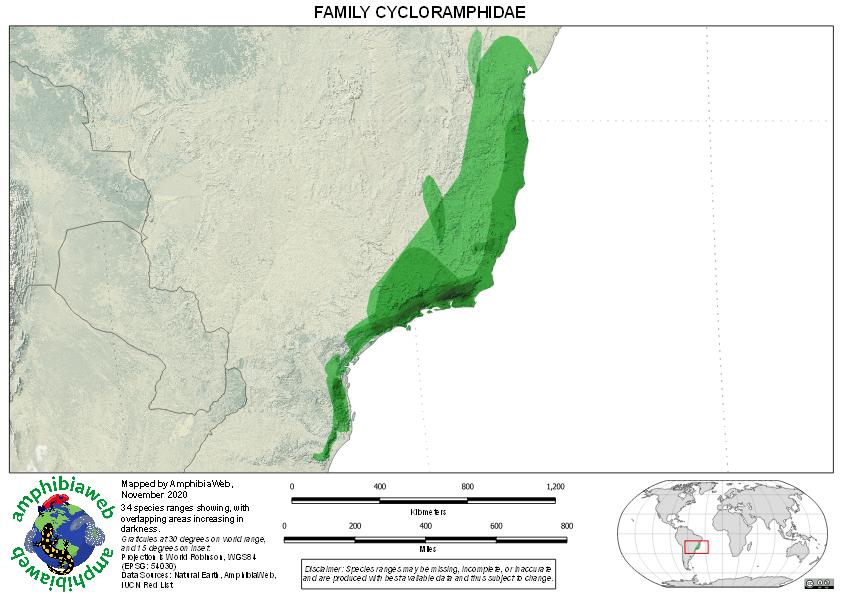Cycloramphidae |
37 species in 3 genera
Commonly Called Button Frogs. River Frogs, or Bug-Eyed Frogs

Cycloramphus duseni
Photo by Germano Woehl Jr.
(Click for family gallery)The family Cycloramphidae contains genera formerly considered to be within the family Leptodactylidae, and once contained genera with wholly unique life history such as Rhinoderma, Mouth-Brooding Frogs, now considered as a separate family, the Rhinodermatidae. Cycloramphidae family now is restricted to three genera, which occur in terrestrial or semi-terrestrial habitats of primary or secondary forests, streams and rocky outcrops in South America. Some species larvae (Thoropa) have adaptations for living in fast-moving torrents of mountain streams; others are considered semi-terrestrial living in the rocks in the splashzone of waterfalls where they forage for food on the streambanks (Cycloramphus). The placement of the genus Zachaenus was once considered too uncertain for family assignment until Guedes et al (2019).
News Highlight:
November 25, 2019: In frogs, breeding in water is the ancestral condition. Yet terrestrial breeding has evolved repeatedly. Recently, de Sá et al (2019) found that terrestrial breeding in the Neotropical frog genera Cycloramphus and Zachaenus (family Cycloramphidae) has independently evolved three times. Terrestrial breeding is thought to have evolved as a way to escape threats to eggs and larvae from aquatic predators. This work shows that an equally important driver of terrestrial breeding could be the high costs associated with high male-male competition and guarding nest territories. They reason aquatic breeding species have limited nest sites in rocky streams, which leads to high competition among males for high-quality nest sites. Females are typically bigger than male frogs but increased male-male competition leads to selection for larger males, reducing the size differences between the sexes. By switching to terrestrial breeding, the higher abundance of sites on land to create nests dramatically lowers the degree of male-male competition and territoriality. This reduces selection for bigger males; smaller body sizes are particularly important on land where desiccation risk is high and being smaller reduces desiccation. In evolving terrestrial breeding, sexual size dimorphism becomes enhanced as selection for larger males is reduced, allowing males to evolve smaller body sizes while females are still proportionally larger to be able to better produce eggs. They nicely illustrate how natural and sexual selection in conjunction to transitions to different breeding habitats may influence the diversification of amphibian life. (MLambert)
Written by AmphibiaWebNotable Family Characteristics
- Terrestrial or semi-terrestrial habitats of primary or secondary forests, streams and rocky outcrops
- Amplexus axillary
- Eggs are laid and hatch into free-living tadpoles with adaptations to semi-terrestrial or torrential stream habitats
- Some morphological features include: 1) paired palatines and frontoparietals in the skull; 2) eight presacral holochordal vertebrae, all procoelous
- Distribution limited to southeastern Brazil in the Brazilian Atlantic rainforest of South America

Cartography Credit: Zoe Yoo, UC Berkeley
Range maps sources: AmphibiaWeb, UC Berkeley, and IUCN RedListRelevant Reference
Guedes, JJM, CL de Assis, CM Novaes, JA Dergam, and RN Feio. 2019. Filling knowledge gaps about the 'Data Deficient' species Zachaenus carvalhoi Izecksohn, 1983 (Anura, Cycloramphidae): an endemic frog from the Atlantic Forest of southeastern Brazil. Herpetology Notes 12:113-204.
Pough, F. H., R. M. Andrews, M. L. Crump, A. H. Savitzky, K. D. Wells, and M. C. Brandley. 2015. Herpetology. Fourth Edition. Massachusetts: Sinauer.
Vitt, L. J., and J. P. Caldwell. 2013. Herpetology. An Introductory Biology of Amphibians and Reptiles. Fourth Edition. Amsterdam: Elsevier.
Genus Cycloramphus (28 species)
Cycloramphus acangatan no account photos no sound/video Cycloramphus asper no account photos no sound/video Cycloramphus bandeirensis no account no photos no sound/video Cycloramphus bolitoglossus no account photos no sound/video Cycloramphus boraceiensis no account photos no sound/video Cycloramphus brasiliensis no account no photos no sound/video Cycloramphus carvalhoi no account no photos no sound/video Cycloramphus catarinensis no account no photos no sound/video Cycloramphus cedrensis no account no photos no sound/video Cycloramphus diringshofeni no account no photos no sound/video Cycloramphus dubius no account photos no sound/video Cycloramphus duseni no account photos no sound/video Cycloramphus eleutherodactylus no account photos no sound/video Cycloramphus faustoi account no photos no sound/video Cycloramphus fuliginosus no account photos no sound/video Cycloramphus granulosus no account no photos no sound/video Cycloramphus izecksohni no account no photos no sound/video Cycloramphus juimirim no account no photos no sound/video Cycloramphus lithomimeticus no account no photos no sound/video Cycloramphus lutzorum no account no photos no sound/video Cycloramphus migueli no account no photos no sound/video Cycloramphus mirandaribeiroi no account no photos no sound/video Cycloramphus ohausi no account no photos no sound/video Cycloramphus organensis no account no photos no sound/video Cycloramphus rhyakonastes no account no photos no sound/video Cycloramphus semipalmatus no account no photos no sound/video Cycloramphus stejnegeri no account no photos no sound/video Cycloramphus valae no account no photos no sound/video
Genus Thoropa (7 species)
Thoropa bryomantis no account no photos no sound/video Thoropa lutzi no account no photos no sound/video Thoropa megatympanum no account photos no sound/video Thoropa miliaris no account photos no sound/video Thoropa petropolitana no account no photos no sound/video Thoropa saxatilis no account no photos no sound/video Thoropa taophora account photos sound/video
Genus Zachaenus (2 species)
Zachaenus carvalhoi no account no photos no sound/video Zachaenus parvulus no account photos no sound/video
Citation: AmphibiaWeb: Information on amphibian biology and conservation. [web application]. Berkeley, California: AmphibiaWeb. Available: https://amphibiaweb.org/. (Accessed:
AmphibiaWeb's policy on data use.
